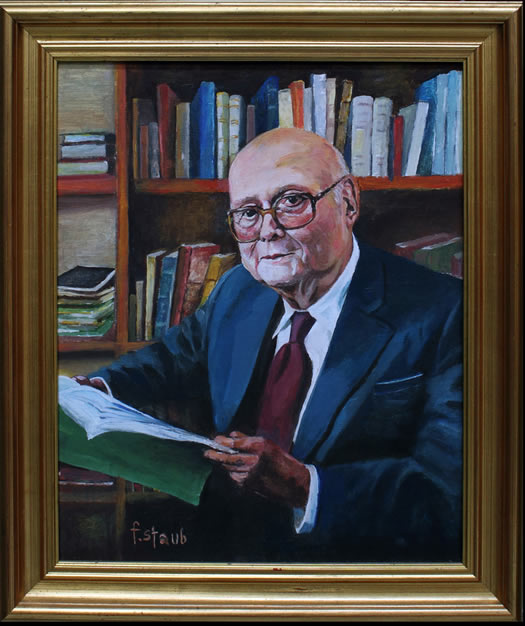STAUB, France
| Nom | STAUB |
|---|---|
| Prénoms | France |
| Dates | 1920 - 2005 |
| Artiste | France Staub |
| Lieu | Dépôt, Blue Penny Museum |
France Staub, who died after a long illness on 2 July 2005, was a Mauritian dentist who combined his practice with a lifelong interest in ornithology, orchids, history, art and good living. He was born on 29 September 1920, and grew up in the then remote and self-sufficient family sugar estate at Baie du Cap; the settlement there is still called Staub. For much of his childhood the bay was cut off from the rest of the island – in 1931 flash floods from a hurricane destroyed the newly built road access; the estate reverted to travel by coastal boat. In these bucolic surroundings France became familiar with the local wildlife, watching (now rare) endemics such as Mauritius Merles Hypsipetes olivaceus and Mascarene Paradise Flycatchers Terpsiphone bourbonnensis in the garden. Although technically protected, Merles remained a local delicacy, the family occasionally eating up to 20 at a sitting. Small chicks were sometimes taken by the endemic kestrel Falco punctatus, by 1973 ‘the world's rarest bird’. After attending the Saint-Joseph College, in 1944 France graduated in science at the Agricultural College (later to become the University of Mauritius), proceeding to Guy's Hospital medical and dental school in London, qualifying as a dental surgeon in 1951. At the agricultural college one of his teachers was Jean Vinson, then Mauritius's only zoologist, who took France and other students on excursions into the forest, where his love of nature became grounded in science. After returning to Mauritius, Vinson invited France in 1955 to join the venerable local natural history group, the Royal Society of Arts & Sciences (established 1829), in which he remained active for the rest of his life, joining its council in 1964, serving several times as its president, and still editing its 175th anniversary journal in 2004; he joined the BOU in 1971.
In the 1960s he regularly accompanied Vinson and other local naturalists on filming and bird-ringing trips to the reptile and petrel refuge of Round Island, and on expeditions to the remote dependencies of St. Brandon (Cargados Carajos), Rodrigues, Agalega and the French island of Tromelin. Often working with botanist Joseph Guého, he produced important papers on each these islands in 1968, 1973, 1983 and 1970, respectively. He discovered that the Rodrigues Fody Foudia flavicans has a brush tongue, but related it to catching insects; it was only later that its active nectar feeding was observed. Also in 1973 he published the first of a series of popular bird books on the Mascarenes, revised and expanded versions appearing in 1976 and 1993 – the last including the entire vertebrate fauna and more. By 1970 he was chair of the Mauritian National Section of the ICBP (now Birdlife), established in 1955. In that capacity, on a visit to the UK, he persuaded David Snow, then chairman of the BOU's research committee, to divert an aborted expedition to Cuba to the Mascarenes, whose endemic avifauna was in danger of disappearing without any ecological study. I was chosen to lead that project, and was very warmly welcomed in 1973 by France, whose good humour and fund of local knowledge were a great help in getting the research off the ground. He was rather rotund, and as he grew less nimble in the field, he devoted more time to his art, painting everything from portraits to abstracts, to his orchids, and to research into the island's history and past personalities, organizing a variety of cultural events. He was always happy to entertain visiting ornithologists, old and new, at the Tropicana restaurant in Curepipe, and ensured they were not undernourished! His last ornithological publications, in the 1990s, explored the importance of seabirds and guano in the history of sugar cultivation, the coevolution of endemic birds with nectar-flowers and fruit, and speculated on the life-cycle and ecology of the Dodo Raphus cucullatus. France was among the last in a long line of Mauritian gentlemen-naturalists, dating back to the mid-1700s, and one of the few in the 20th century to publish seriously and become well known to the general public; he was a regular and generous correspondent, and a good friend for 32 years.
France was always good company, had an infectious sense of humour, and was a marvellous raconteur, always ready with stories of his student days in London and his adventures in forests and islands. One of the most hair-raising was in the 1960s when he was exploring with Vinson a deep cave for endemic swiflets Aerodramus francicus, when local vandals lit a huge bonfire of old tyres in the entrance, coming close to suffocating the naturalists. France's tales of trysts with delightful damsels seem, however, to have been entirely apocryphal – and he never married. He carried on with his dental practice into his 80s, too long for his reputation, but then Mauritius has no state pension. He is commemorated in a vine, Cynanchum staubi (Asclepiadaceae), which he discovered in 1965 on Ile aux Aigrettes, an offshore islet nature reserve now the focus of intensive ecological restoration.
ANTHONY CHEKE
Source
Extrait du International Journal of Avian Science (IBIS), Volume 148, Issue 3, July 2006 : 610–611.
La RSAS remercie l’auteur de nous permettre de reproduire ici cette biographie.


